Randall writes:
While I’m not exactly a newbie when it comes to *using* firearms, I am a newbie gun *owner*. And now that I’m in the position of purchasing ammo, I’m finding things to be rather confusing when sorting out all there is to be had. I think I’ve kind of figured out what I want to buy for my Springfield XD 9mm, but choosing ammo for my AR-15 is proving to be more daunting. How ’bout an article for us newbie-types explaining the differences between, say, “full metal jacket” versus “total metal jacket” versus “jacketed hollow point” versus “jacketed hollow point subsonic” versus “frangible” versus “full metal jacket boat tail” versus “soft point” versus “boat tail hollow point” versus “lead round nose” versus “semi-wadcutter” and “safety slug” versus…you get my drift. And then the companies, Winchester, Remington, Federal, and on and on.
That’s a pretty wide-ranging question, so I’ll answer it in three parts. This first part is all about the different types of projectiles, and there are quite a few. But first, in order to explain the different designations, a little about how bullets are made . . .
A few weeks back, I took a trip to the Hornady manufacturing plant in Grand Island, Nebraska. It’s a good read about a strong United States company, and I recommend you take a look, but this picture is the one we really want to focus on.
The vast majority of common type jacketed bullets are constructed of a solid lead core and a copper covering (called a “jacket”) that contains the lead. Lead is used because it’s an extremely dense yet cheap metal, making it perfect for giving projectiles their weight while keeping the overall size small. Copper is used because it is strong enough to keep the softer lead in shape, but is soft enough to allow the rifling to grip the bullet.
The copper jacket starts out as a cup, having been cut from a long sheet. Through a process called “drawing,” the cup is lengthened and shaped to fit the profile of the projectile they’re making. These cups will eventually end up as jackets for 5.56 NATO rounds.
However, while this process is very efficient, it’s extremely difficult to actually get the metal to encase the entire lead core without any gaps. To keep production costs down, bullet manufacturers usually leave one end of the projectile open. Which end is open – and how that’s done – determines the classification of the projectile.
Here are three 150-grain .308 caliber (bullet diameter) projectiles (a “grain” is a unit of weight that tells how heavy the bullets are). And while they look very similar, the way in which they were manufactured is very different. The first projectile on the left is a “full metal jacket” round with a solid copper point. The other two are an open tip and a soft point bullet respectively, with openings in the copper at the tip of the projectile.
Looking at the bases of the projectiles we can see why they’re different. The “full metal jacket” bullet does actually have an opening, but it is at the bottom of the round. So, why are these bullets different? Let’s go over each one in turn.
Full Metal Jacket (FMJ)
“Full Metal Jacket” or “FMJ” projectiles usually aren’t actually “full” metal jacketed, but simply have a copper jacket covering the top of the projectile. Military FMJ bullet designs are completely covered by a copper jacket (as per the Hague Conventions), which uses a more involved process than traditional civilian ammunition (but doesn’t alter the lethality of the rounds).
FMJ ammunition is manufactured so that the bottom of the original cup of copper becomes the tip of the bullet, producing a continuous jacket of copper over the top of the round. However, most civilian ammunition leaves the soft metal base of the lead core uncovered, as illustrated with the bullet on the left in the above images (the ones with the three bullets side by side).
FMJ ammunition is cheap to produce, and therefore is the traditional choice for use on the firing range. The uniform and aerodynamic design of the spitzer projectile also makes it the ideal choice for long range precision shooting. However, that streamlined design means that it’s also more likely to penetrate a living target (like a human or a big game animal or a varmint) and keep going out the other side, possibly injuring people further downrange and leaving only a small wound in the target. Therefore, for home defense and hunting, it’s not advised to use FMJ ammunition.
There are a couple variations of FMJ ammunition that can be recognized by their designations:
- Round Nose (RN) — The tip of the bullet is simply rounded in a spherical shape, not particularly aerodynamic. Used mostly in handgun ammunition and older rifle ammunition.
- Boat Tail (BT) — In a boat tail bullets, the rear of the bullet is tapered to give it a more aerodynamic profile. This is common in “match” grade rifle ammunition and long range target ammo.
FMJ ammo is the “default” type of bullet style, and the only one where the jacket is “drawn” from the tip. Every other projectile uses a jacket that is “drawn” from the base, and the tip is usually designed to perform some sort of function.
Open Tip (OTM)
With FMJ bullets, the bottom of the cup becomes the tip of the bullet. With “Open tip” rifle bullets, the opposite is true — the bottom of the cup is the bottom of the bullet. While this covers more of the lead core than the FMJ projectile, it leaves an opening at the tip of the bullet where the jacket was drawn together. Many people mistake this for “hollow point” ammunition, but the point is too small to work that way.
Open tip bullets are preferred for long range shooting as the manufacturing process is more consistent than with FMJ projectiles, leading to higher quality bullets and better performance at long distance. These projectiles are often referred to as “OTM” or “Open Tip Match” to indicate that they are held to a higher standard for target shooting than regular ammunition, and generally have better regulation of propellants, thus speeds.
Due to the construction of the projectiles, open tip bullets perform nearly identically to FMJ projectiles.
Hollow Point (HP)
For self defense or hunting, hollow point bullets are the way to go. Following the same general manufacturing process as the “open tip” bullets, these projectiles feature an exaggerated opening at the front of the bullet. The idea is that this opening will force the projectile to expand upon impact with a target, dumping all of the energy of that round and creating a massive wound for top stopping power. However, that gaping hole of exposed lead in the front of the bullet also creates an immense amount of drag and negatively impacts the long range capabilities.
However, hollow points can be found in various bullet sizes, from .22-caliber bullets for rimfires and a variety of centerfire handgun and rifle rounds, such as 9mm Luger (or Parabellum), .357 Magnum, 44 Magnum, .45 ACP (Automatic Colt Pistol) and the range of long-arm cartridges from .17 to .50 calibers.
Gun control advocates have successfully branded hollow point rounds as “cop killer” bullets in a couple states and have implemented legislation banning their use based on the claim that they are in fact “armor piercing.” However, as we have tested and proven, that’s not the case.
Hollow point ammo is the favorite choice for police officers and those who carry a concealed weapon for one simple reason: when they hit something, they stop. They don’t keep going like FMJ rounds can and injure people on the other side of the target. When a hollow point is combined with a jacket, it becomes a jacketed hollow point (JHP) bullet. With a slimmed back end, it becomes a hollow point boat tail, or HPBT or BTHP.
Soft Point (SP)
While hollow point ammunition is great for handgun rounds, when you’re hunting at longer ranges with a rifle you need a round with better ballistic properties. One of the first attempts to make a projectile with the accuracy of a FMJ bullet and the “terminal ballistics” (how well it does when it hits a target) of a HP round was the “soft point” bullet.
The main difference between a soft point bullet and an open tip bullet is that with the SP, some of the lead core is protruding from the front of the round. This gives the bullet a more aerodynamic shape than the OTM bullets, and also has a tendency to flatten the projectile when it hits a target. The bullets don’t open up as dramatically as a HP round, but it’s still better than nothing. Especially where HP rounds are illegal.
But if you’re looking for a really good hunting round for your rifle, there’s something far better out there than a soft point bullet.
Ballistic Tip
How do you get the benefits of a hollow point with the long range accuracy of a FMJ? By adding a small piece of plastic. “Ballistic tip” bullets feature an exaggerated opening in the tip of the copper jacket to allow the bullet to expand upon impact, but that hole is covered by a cone shaped piece of plastic that allows the bullet to perform as if it were a FMJ. It’s a pretty nifty design, and one that I use to great effect in my hunting ammunition. I used a ballistic tip bullet to bring down a deer on opening day of the last hunting season.
Other Bullet Types
While a lead core is the standard for bullet construction, there are some other interesting designs that are purpose built for specific roles. Here are a few:
- Frangible — These bullets are made out of compressed granules of copper, and are designed to shatter upon impact with a hard surface. They are used mainly as training ammunition in shoot houses, where over-penetration is a serious concern.
- Steel Core / Armor Piercing — The lead core is replaced with a solid dart shaped chunk of steel, designed to pierce body armor and some light skinned vehicles. This is the standard M855 5.56 NATO ammunition. This can ruin steel targets, and cause ricochet hazards if used improperly.
- Tracer — A chemical is painted onto the projectile that burns as the round flies downrange. This allows shooters to see where their bullet flies, but also keeps burning after the projectile lands and can start fires.
That’s about the long and short of the different types of bullets. Tune in next time for “why does the grain count matter?”
[Email your firearms-related questions to “Ask Foghorn” via [email protected]. Click here to browse previous posts]

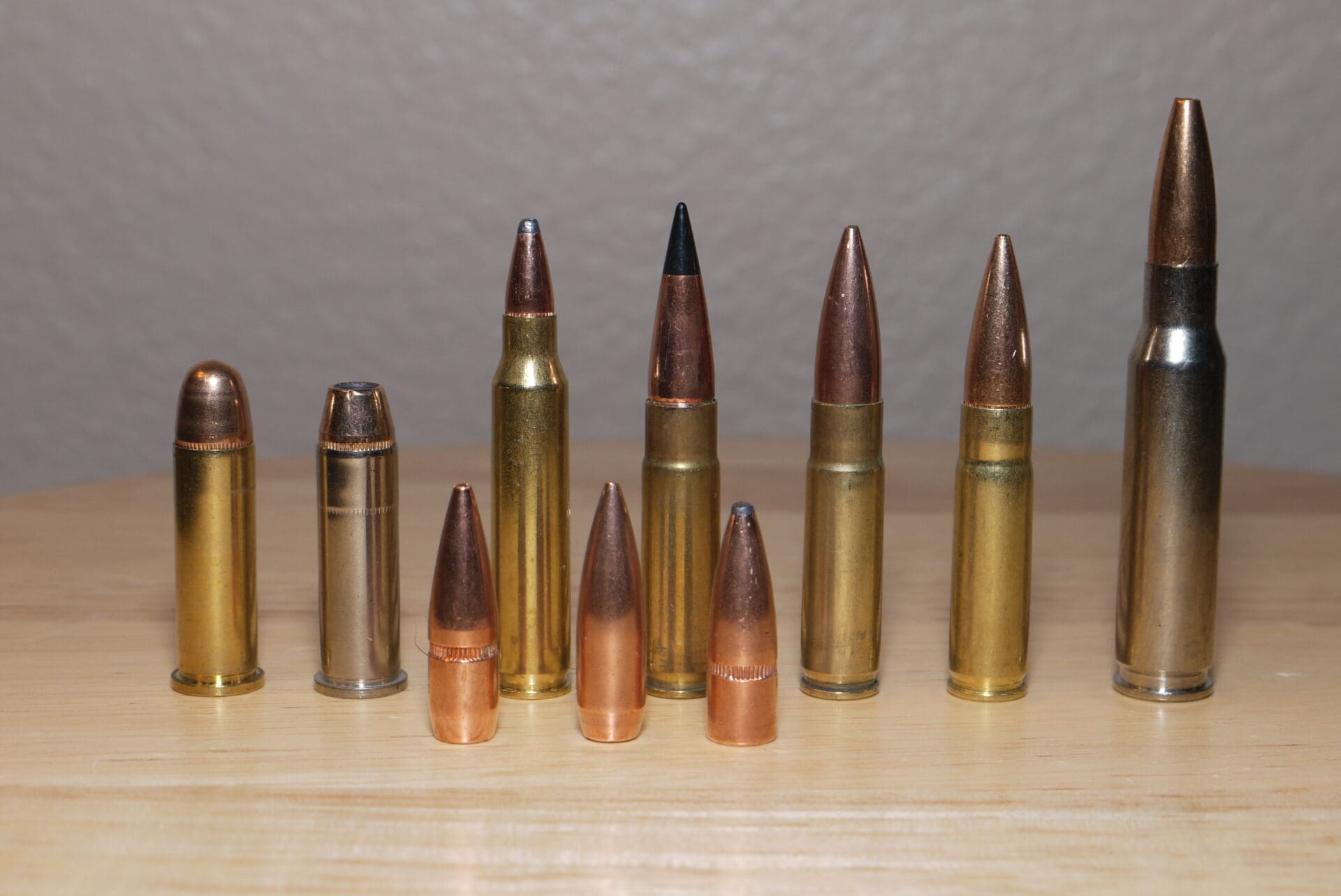

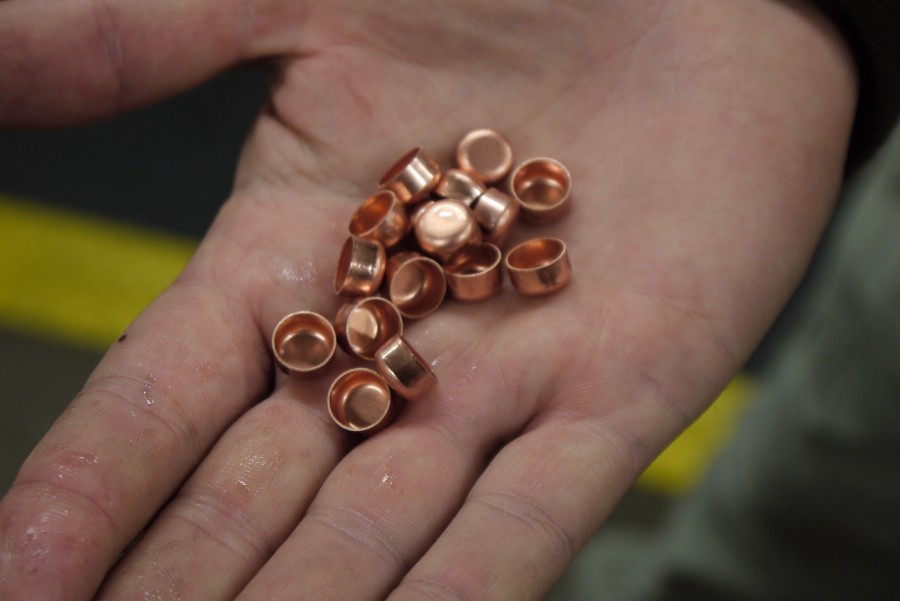
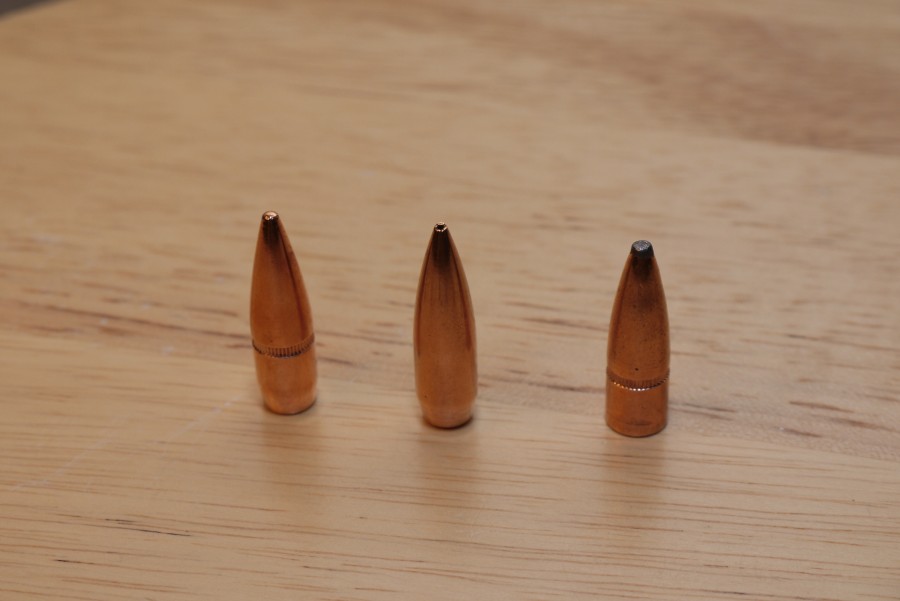
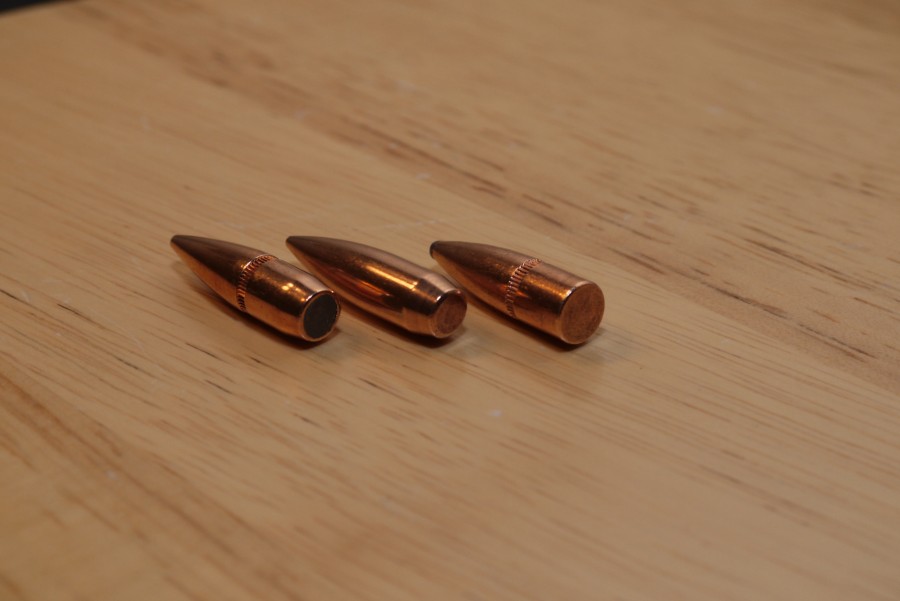
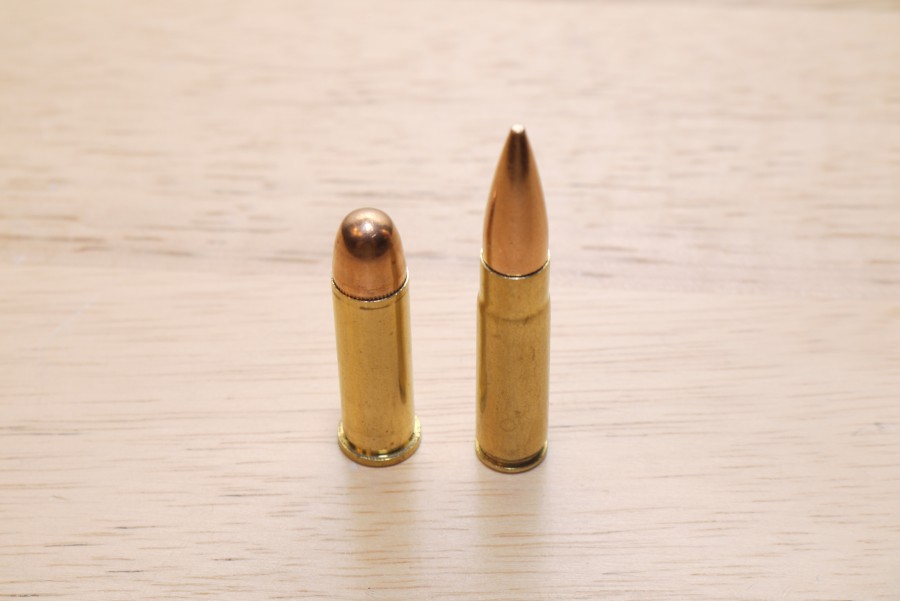
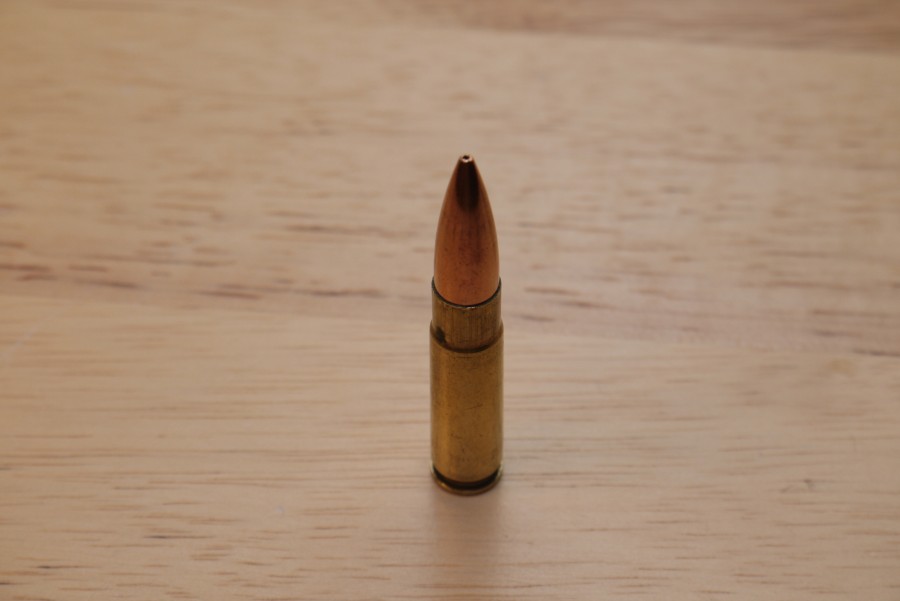

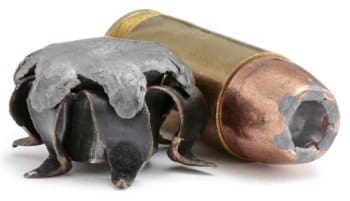

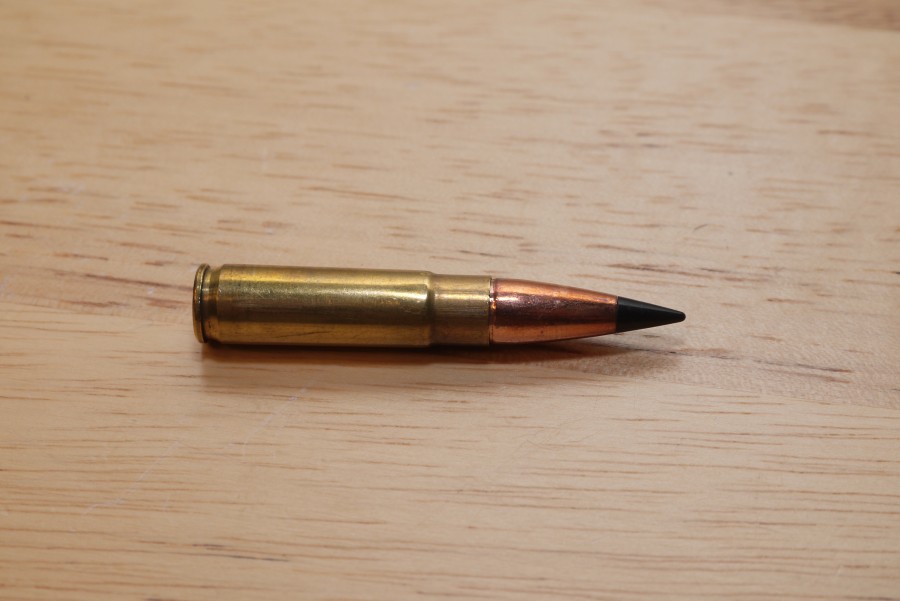



I thought tracers had the rear part of the core replaced with a flammable material, ignited by the burning gunpowder.
Also, at typical rifle velocity, a pistol type HP bullet would fragment. The ballistic tip isn’t so much a means of replicating a pistol HP, but rather to keep soft lead points from deforming. The plastic retains its shape when pushed against a feed ramp.
*edit* look before you peep.
I fire HP bullets out of my 357 magnum lever-gun at 2000 fps. I would call that rifle velocity, and it does not disintegrate coming out of the muzzle.
Sorry, I didn’t mean fragmenting in flight. I meant that when striking a target such as a game animal, the walls of the cavity would fragment away from the core.
I would like to see gel tests of your .357 rifle loads, Randall. You may find that the forward portion fragments, or folds back alongside the bullet (negating part of the hollowpoint effect if it folds all the way back), or functions the same as in a pistol.
You are right, that falls in the realm of rifle velocity. However, when many of the pictures in the article are of spitzer type bullets that commonly travel at 3000+ fps, I wasn’t really thinking of a case like yours. Consider my mind opened.
I have a Marlin 1894, .357 magnum lever action. I did water tests with some winchester-nosler jacketed hollowpoints, 180 grain A-frames made for hunting. Out of my 5″ pistol, they mushroomed perfectly, and penetrated 4 1 gallon water jugs. Out of the 18″ rifle, the petals fragmented off. The petals stopped in the second and third water jugs, while the rest of the bullet penetrated through the 5th jug, acting essentially as a solid at that point.
Don’t forget total metal jacket.
Yeah, I clicked on a KABA newslink because I didn’t know what TMJ meant. Now I’ve read an entire article on the subject and still don’t know what TMJ bullets are.
yeah he SHOULD have touched on it. You’re more than welcome to copy my post into the article if you want.
TMJ (Total Metal Jacket) usually applies to the inexpensive reloaded rounds that you can buy at gun shows and ranges. Reloaders know them as copper plated bullets, Xtreme and Berry’s are well known manufacturers of these bullets. In fact, you cannot buy TMJ bullets that I know of, just plated. TMJ is a term used when they sell these bullets in reloaded cartridges.
Rather than taking copper and forming it into a cup, then filling it with lead, they start out by forming the lead shape, then plating it in copper. The copper covers 100% of the lead, but it’s also cheaper and easier to produce. It occupies a slot in between lead bullets and FMJ both in price and performance. Many indoor ranges like plated bullets because all of the lead is encased in copper, so none of it is vaporized. However, copper plating is not as thick and therefore not as durable as FMJ therefore you can’t push the velocities as fast as you can with FMJ. You can’t push them faster than 1500-1900 fps, depending on its construction/caliber. For pistols that is usually no problem, but that is why plated bullets are rare for any rifle rounds. I load Xtreme 7.62×39 and you aren’t supposed to push that particular bullet any faster than 1900fps.
All in all, plated bullets are great for range use in pistols and aren’t nearly as messy/limited as lead, I do load all different types but I still mostly use lead for pistol because of the price.
They did, back in the day.
The British introduced the first “tracer” bullets during World War I in 1915, and the US followed up with their own version in 1917. In both cases, there was a small chamber in the rear of the projectile that was filled with phosphorus. The muzzle flash would ignite the phosphorus, and the phosphorus would burn as the bullet flew through the air, leaving a trail of blue smoke showing the path that the bullet had traveled. These rounds were loaded into a magazine so that every third bullet was a tracer. They allowed the shooter to adjust his aim, and also allowed his fellow soldiers to see exactly what/who he was shooting at so they could dial in on the target as well.
But there were a few problems with these rounds. First, they obviously didn’t work very well at night. Second, their effectiveness was dramatically lessened when firing in dense fog, or in an area that already had a lot of smoke in the air, like where artillery may have set buildings, vehicles and organic matter (trees, shrubs, etc.) on fire. Third, a smoke trail also works in reverse, showing the enemy exactly where to fire back, and this basically defeats the entire purpose for the use of smokeless powder. A glowing bullet, such as a modern tracer, flashes by quickly and then is gone, so it does tree job without leaving a smoke trail lingering in the air like a neon sign saying “shoot me here”.
Modern tracer rounds, like the article says, are coated in a luminescent chemical that burns at extremely high temperatures.
You said “light-skinned vehicles”. Racist.
Ha ha ha…… 🙂
So is my black… er… African-American truck immune?
Not from the LAPD, no.
Nice write up!
As another person relatively new to firearms, and trying to decipher the blizzard of terms, types and “shorthand” that’s used on many of the sites, I truly appreciate this article (and am looking forward to the next ones!) as a very useful primer (no pun intended there…).
Nice Read, oh and yes Ha Ha @ kenpm
“Copper is used because it’s actually softer than lead and will readily slot into the rifling in the barrel of the gun.”
Copper is NOT softer than lead. It is soft enough to deform/bite into the rifling, but hard enough for the bullet not to damage/deform in handling and storage, and hard enough not to leave lots of deposits in the barrel and rifling.
Also “grain” is a unit of weight not a unit of mass.
^ What he said.
Additionally, without a copper jacket, lead bullets can deform as part of the firing process affecting their aerodynamics. It’s more problematic with higher velocities.
And there’s the safety factor that lead bullets produce lead vapor, while copper doesn’t vaporize much at gun temperatures.
True, and next time I’m reloading on Mars or in a relativistic environment, I’ll keep that in mind.
Well played, sir.
Indeed, copper is harder than lead, which is exceptionally soft for a metal.
And thumbs up, weight and mass have a relationship, but are not the same thing. Kinda like Justin Bieber and Taylor Swift.
A small dab of phosphorous is painted on the tip of the round, and the friction of passing through the air at high speed ignites it. This makes the bullet light up, but can also cause fires downrange.
Nope. Nope nope nope.
A pyrotechnic mixture is contained in the base of the bullet, ignited upon firing and lighting up with a trail much as a firework does.
….but it can still cause a fire downrange 🙂
Sure enough. Seen it many times. It can be a real quick way to stop a FTX.
Oh yeah.
Especially when someone creates belts of all-tracer 7.62 for the night shoot. Because he always wanted a laser cannon.
Fixed. Bad copy/paste, didn’t mean to publish.
You still have it wrong. A pyrotechnic mixture is made and then pressed into copper cups. This tracer pellet/cup is pressed into the base of the bullet with the open end facing where the powder will be. There’s no painting involved except the designator marking on the bullet.
In Vietnam we would sometimes load a newbe’s mag with all tracers, usually when they thought it was cool to empty the mag in one burst. They tended to get excited when they started to fire.
Tracers have the phosphorous on the base of the bullet.
I’ve always used the soft point bullets for hunting. Initially that’s because they were the only kind available. Now they have the fancy ballistic tip and other type of “special” hunting bullets, that raise the cost of a box of 20 30/06 to $35-$40 or more. I still use the soft points at about $19 a box. I have always killed my deer with one shot. IMO it’s not the bullet or the rifle, it’s the rifleman. YMMV
By and large, I would agree – without reasonably good markmanship, it won’t matter how much you spend on ammo. My only observation as regards the PRICE of premium ammo versus softpoints lies in the quantity used for hunting purposes. In a typical high-quality bolt action rifle with a good, solidly mounted scope, it’s possible to zero with only a few rounds at a given distance, and then only a few more rounds may be fired at the game being hunted (an obvious exception being varmints.) Taken in this context, many hunters, regardless of their marksmanship, are willing to spend the extra $20 per box on a given load, particularly if it proves to be especially accurate. I have an old sporterized vz. 24 rifle in .270 Winchester passed down through the family that is known to be extremely accurate, but as it’s been perhaps 50 years since anyone’s fired it, I’ve no way of knowing what load would group best. So to that end I’m slowly assembling a few boxes of good ammo. Some Federal 130grain softpoint but also a box of Remington 130gr Sirocco bonded, and a box of 130 grain Winchester Silvertips. Neither of which are cheap, but in the scheme of things I’m not buying 10 boxes of them either. Just one, and if it groups well maybe another. Thankfully .270 seems to be plentiful, which is a mystery to me. Surely there’s more .270’s out there? My store has some left over from LAST SUMMER, even through the ongoing shortage. Just one more thing that’s not to understand why.
Overall, I thought it was a decent article. Remember it was intended to answer questions of general interest regarding ammo, not to provide a treatise on internal or external ballistics for each known type of cartridge on the market. Lighten up a little, folks. None of us are perfect (I know I ain’t 🙂 )
“Copper is used because it’s actually softer than lead and will readily slot into the rifling in the barrel of the gun.”
You are wrong about copper being softer than lead. The Mohs scale of mineral hardness has lead at 1.5 and copper at 3.
http://en.wikipedia.org/wiki/Mohs_scale_of_mineral_hardness
I suspect copper is used for jacketing because it is HARDER than lead and thus allows for higher pressure while being fired.
Copper also work hardens, so depending on how much stress is placed on a jacket during drawing and shaping, the hardness may differ. Some bullets are electroplated, and are very ssoft.
I’m thinking “ssoft” sounds VERY, VERY soft…. like Charmin.
And to combine with a comment above about higher velocities, I’ve read that copper jacketed bullets were developed because the soft lead bullets in common use at the end of the 19th century were literally stripped going down the barrel of a high velocity rifle, not only causing very fast leading of the barrel, but eliminating the benefits of the rifling. Further, copper can take a higher twist rate. For comparison, the rifled muskets of the Civil War had a 1:48 twist rate, while more modern black powder rifles that shoot sabots and jacketed slugs are 1:25.
Yes, at higher velocities, lead starts to strip off the bullet as gas works its way past.
There’s a way to ameliorate this to some extent, by the addition of a copper cup on the base of the lead bullet, called a “gas check.” Still, there are limits to how fast you can drive a lead bullet.
The other thing that improves the situation is to use harder alloys of lead. One of the older favorites for lead bullet fans was the Linotype alloy.
Copper jackets were also developed for the military because they were starting to use the belt fed water cooled machine guns like the Maxim. Exposed lead ammo sheds and deposits lead thru the loading and handling process and effects reliability.
Over all this is not a very good article about ammo.
Military FMJ bullets are not totally covered in copper, the lead is exposed on the base.
And what you said about tracers is the same thing I tell my “special” soldiers to mess with them.
But but but that’s why the tip is orange and not green, right?
Oh the things privates tell each other.
“FMJ ammunition is cheap to produce…the uniform and aerodynamic design of the projectile also makes it the ideal choice for long range precision shooting.”
Uhhh…no. We mostly use hollow point boat tails, like the Sierra Match King and Hornady A-Max. The full copper tail gives it more consistency out of the barrel than you’d see with a lead base, because lead deforms easily. A deformed base can induce wobble and turn a hit into a miss at 1km.
We have the range…. Now FIRE for effect!
Tough to be the writer today…
M855 was removed from AP listing a while back due to not meeting the criteria of not have a complete steel core as they have steel and lead as well as the ATF exempting them from the categorization of AP.
True that, it is at best, classified as semi-AP.
Isn’t it great we have gov’t employees out there to determine such questions? Exactly what the founding fathers had in mind for this experiment.
Good read.
In Kommiefornia, we cannot hunt with lead core.
It would have been good to see you address this kind of hunting ammo in some detail.
DrVino, I believe the non lead ammo is only in the “Condor Range” areas of California. If I remember correctly you can use lead ammo in different parts of the state.
^^^ yes this
we are actually REQUIRED to use a soft or expanding bullet in hunting, it’s the condor zone that makes lead illegal to use.
353. Methods Authorized for Taking Big
Game.
(a) Except for the provisions of subsections 353(b)
through (h), Title 14, CCR, big game (as defned
by Section 350, Title 14, CCR) may only be taken
by rifes using centerfre cartridges with softnose
or expanding projectiles; bow and arrow
Actually the tracers have a small pyrotechnic compound at the base of the projectile, which is ignited by the propellant.
And yes, they are a hazard in the woods. However, they’re a million laughs at the range when you’ve got a dozen balloons filled with propane or acetylene on the backstop.
Actually, part of the military specification for M855 calls for penetrating 10ga steel plate at 600m. While it’s not written in the spec sheet, I’ve been told this was intended to punch through issue Warsaw Pact helmets.
Usually, rounds designed specifically as AP are black tip for US military, but to say the M855 is not at all armor piercing is not correct. And yes, I know almost all rifle bullets will go through soft body armor.
The reason the ATF does not consider it AP is, I believe, because it has a two piece core. ATF looks at partial steel core as not AP, but if it had a full steel core it would be a different story.
Edit- Chris beat me to the ATF explanation.
weelllll, I guess it could have been better researched.
I tend to cringe when inaccurate information is given to a new member of the shooting community by someone they trust enough to even ask in the first place.
Live and learn I guess. A minor revision here would be welcome. The Truth About Guns is only worth reading it if is actually the truth.
An earlier, mostly copy/pasted version was published by accident. I have fixed the issues.
Most FMJ military pills are “Spitzer” style bullets. The boat tail variant is important for long range shooters, especially where bullets will transition from supersonic to sub-sonic. Spitzers were how the Mauser 7×57 round took everyone by surprise when everyone else was using round-nosed bullets.
Some important types of projectiles are missing from the list:
– Total metal jacket (TMJ) – enloses the bottom of the bullet with a copper jacket as well as all frontal areas. FMJ usually leaves the lead base of the bullet open.
– Solids. Used in dangerous game hunting where you want to maximize penetration and weight retention. These are typically made from bronze or brass alloys, with some newer designs being solid copper. The classic dangerous game cartridge company, Kynoch, is well known for their solids. Barnes is producing some solid hunting bullets as well.
– Sabot – a smaller bullet is contained within a plastic or similar “cup” that holds the small bullet in contact with the case neck and the grooves of the bore. The sabot is light enough to peel away as the bullet exits the muzzle.
An example would be a .224 bullet in a .30-06.
The old school method of accomplishing something similar, but not quite as dramatic in terms of bore diameter difference was to paper-patch a bullet.
– Jacketed flat nose – used in lever guns like the .30-30. Pointed bullets in tube magazines of centerfire cartridges is a no-no.
– Wad cutter – used in handgun rounds to make very nice, clean holes in targets. There are also ‘semi wad-cutter” bullet profiles. Usually lead, sometimes copper-plated.
And then there are all the lead cast and swaged bullets not mentioned here.
Had a friend who used to load hollow back wad cutters reversed. made an awesome home defense round. Absolutely NO over penetration, 100% energy transfer and a massive wound cavity. The one guy he shot made it three steps down hte hall from his bedroom.
I think the snipers in WW1 would do that. They would shoot at metal plates in their enemy’s trench to create shrapnel and throw it all over the trench.
TMJ are referring to copper plated rounds also, see my post up above. cheaper to make/buy but they can’t be pushed to rifle velocities, they can shred apart if pushed “normal” rifle velocities.
Obviously you’re new here or you would not be making such a stupid assertion as claiming Foghorn is some MSNBC author. Foghorn has forgotten more about guns then many people are ever likely to learn. That said, no one is an expert in everything and mistakes can be made. Foghorn did not make a mistake on the M855 round. From Wikipedia (which itself was sourced from the Small Arms Review),
“In 1977, NATO members signed an agreement to select a second, smaller caliber cartridge to replace the 7.62×51mm NATO cartridge.[11] Of the cartridges tendered, the 5.56×45mm NATO was successful, but not the 55 gr M193 round used by the U.S. at that time. The wounds produced by the M193 round were so devastating that many[12] consider it to be inhumane.[13][14] Instead, the Belgian 62 gr SS109 round was chosen for standardization. The SS109 used a heavier bullet with a steel core and had a lower muzzle velocity for better long-range performance, specifically to meet a requirement that the bullet be able to penetrate through one side of a steel helmet at 600 meters. This requirement made the SS109 (M855) round less capable of fragmentation than the M193 and was considered more humane”
Don’t know about you, but if the bullet was specifically made to penetrate one side of a steel helmet, it would seem to me to be designed to penetrate some forms of body armor. Of course anyone who knows squat about body armor knows that most rifle rounds will penetrate soft armor but most rifle rounds will not penetrate Type IV ceramic plates. Not everyone uses Ceramic plates and in some parts of the world, steel may be used with properties similar to the steel helmets the M855 was designed to penetrate.
Yeah, unfortunately it looks like an earlier template was posted instead of the finished article. I have updated the post to the newer version.
It happens, Nick. You seem to be the kind of stand-up guy to fix things when they’re wrong.
On the other hand, I still haven’t heard anything from RF about the MAIG hunter post. Good thing I wasn’t holding my breath. I’d be quite blue at this point.
I always thought open tip rifle bullets made them fragment easier. Guess not?
Nope! Most FMJ and OTM rifle bullets start to yaw (move sideways) through tissue type media within a few inches of penetration. Then they either snap in half or deform into a banana shape. They may, but tend not to, fragment.
For a long range bullet for precision shooting that also fragments, you’d want to look at bullets like the Hornady A-Max, which has the ballistic type tip.
Of course, tracers work both ways.
SS-109/M855. All one needs to know. If you want tracers (and who doesn’t?), M856.
Good article on the basics, just what the reader asked for.
Does anyone know of a mobile app that provides basic ballistics, much like was used to be in the back of the Annual Gun Digest? I felt that was very useful as it had velocities, drop, etc and notations on manufacturers.
The 5.56×45 NATO round was designed for wounding a person, problem was, that once it hits a person, it has the tendency to “tumble” upon contact with a soft target i.e. a person or a small animal. Hell You can take down a dear with a 5.56 if your aim is well enough to move between the intercostal tissue and hit the heart, or go through an eye straight to the brain. But that take EXTREAM marksmanship! My motto is “to believe none of what you hear and only half of what you see” that said. I did hear of a story of a soldier hitting a, it think it was a Vietcong, maybe not, but the bullet entry point was high on the body and they could not find an exit wound or the projectile any where near the entrance wound. So…they were stumped. did the bullet just disintegrate? or maybe something else happened, like it went back out the same way it came in? Nope. upon autopsy they found the round in the mans foot, it had hit an artery, a large enough one, and was pumped all the way to his foot where it got lodged and could pass no further (Now if that is true or not I don’t know, but it is plausible.). Another point is that in this recent war, in Iraq and Afghanistan, inquires were being held against the soldiers, thinking that they were just lining “combatants” up and shooting them in the heads, like the gangsters did. But, they were hitting theses people in the heads so often because that is all that would be presented to the soldiers to shoot at. And in the “normal” combat ranges of 100 yards or less, and the ease of shooting the NATO round, of course they were having such a high head count…get it lol. That was a bad joke, anyway, the only problem with the current battle round is when shooting at a lightly armored enemy combatant the round just does not have the terminal ballistics to keep up with a .30 cal. round aka the Russian 7.62×39 or by 54r. I believe it has been far too long to make a move to one of the 6mm cartridges i.e. 6.5 or 6.8mm they are like the .40 S&W of hand gun rounds. 9mm fast accurate not a lot of terminal ballistics, .45ACP BIG round heavy moves slow but a lot of terminal ballistics. then there is the .40 cal. faster than the .45, heavier than the 9mm, just as accurate though, and carries a terminal ballistics rating smack dab in the middle. It’s the best of both worlds, in my opinion. I own a Spring Field Armory XD-M in .40 S&W and love it. It kicks more than the 9mm, but hits harder, weighs less than the .45ACP, but is cheaper to shoot on a regular basis. Arguments can be made about anything in this world, literally!
Well, it took a while, but *thanks* for getting around to it! I appreciate the info.
Good basic article, but I also appreciate some of the informative facts in the comment section. GJ, TTAG.
Ahhh. I see how this works. I post a comment pointing out that the author either posted misinformation or was misinformed, and that some of his information was so wrong that it could be used as fodder against lawful gun owners, on a site called The TRUTH About guns, and my post gets deleted.
Mr. Barret, if the author knows so much, then why the inaccurate statements? And to answer the comment on armor piercing bullets, I saw no mention of helmets – only bullet proof vests. I’m not sure how much time you spent in the military, but I can say from experience and certainty that the bullets mentioned were NEVER tested against modern bullet proof vests by the military.
My concern was (and still is) that the information was not well researched or was researched using unreliable sources. Which is very bad, given the current heightened state of the anti gun people.
My reference to left wing media was correct. It is common for wrong or inaccurate information, posted as an article on a very well respected web site, to be taken as “the truth” by novices and/or those who wish to use such media against us. Didn’t we just see this in the latest court case in Florida?
Further, to delete my previous post simply shows that you are more willing to ignore than to rebuke critics. Probably not good practice, bit I assume you will delete this post also….
Nick said it was an early draft published in error, published the right one, and deleted the comments addressing the errors. Is there still something in this version you have an issue with?
Yes. It still says “….designed to pierce body armor….”. That is not true, and is the focus of my critique. That bad information has been used before against gun owners – remember Black Talons? Armor piercing rounds were around way before 1977 when the 5.56 was tested and way before “modern” body armor.
Your critique about body armor was partially valid, but you seem to have ignored both my response and Jim Barrett’s which specifically address it.
No, soft kevlar vests and Warsaw Pact helmets are not the same thing. Both, however, protect (armor) important parts of the body. Yes, the specific bullet used in the M855/S109 loading of the 5.56mm NATO cartridge was designed in part to penetrate Warsaw Pact helmets. Thus, it was designed to pierce body armor. Or perhaps I should say ‘head armor,’ but I’m pretty sure that’s a ridiculous term nobody has ever used before.
From the text of MIL-C-63989C, the spec for M855;
Penetration. The bullet of the sample cartridges shall demonstrate complete penetration of 10 gage (.135 inch) thickness AISI 1010 to 1020 steel plate target with hardness between RB 55 minimum and RB 70 maximum, (NATO plate) positioned at O & So obliquity and located 656 yards (600 meters) from the weapon. Additionally an aluminum witness plate (2024-T3 or equivalent nominally 0.020” thick) shall be located 6 inches behind the target to determine penetration. Testing shall be performed when the air temperature is between 300F and 95° F. This test shall only be performed for the First Article test and for the first three production lots. If the requirement for penetration has been successfully met for the First Article and three (3) consecutive production lots this test may be discontinued.
Nick was right.
Nice article, Nick, thanks.
Grains are an old measurement. There are 7000 grains to the pound. But for small measurements, they are ideal. Especially for bullet weights and powder charges.
Foghorn, in the next section on grains, you will have to mention how heavy bullets need a faster rifling pitch. And how do you determine the pitch? There is a mathematical formula called the Greenhill Formula to calculate the optimal rifling pitch. Manufacturers will then round the number down to the nearest whole or half-inch for ease of manufacture. There is very little disadvantage to using a slightly faster (ie: lower number) rifling pitch than optimal, but there is no benefit to using a rifling pitch slower (higher number) than optimal as the bullets will not be adequately stabilized and have accuracy issues.
Link 1: http://kwk.us/twist.html
Link 2: http://www.ebr-inc.net/articles_Greenhill_Formula.html
Ok then. I’ll have to admit that I’m wrong, and I guess stupid. Next time I go ask for steel core ammunition, I’ll need to refer to it as body armor piercing ammunition. Because of course ammunition designed to pierce helmets as a criteria would HAVE to also have been designed to pierce body armor, since that is the first thing the article on The TRUTH About Guns mentions when it describes armor piercing ammo.
I have always wondered about those “hollow point” 45 grain cartridges Winchester and a few others sell for the .22-250. They are technically open tip based on what I read here. That makes sense given they are 4000 fps or higher for long range shooting.
GOOD ARTICLE!!
One thing to add, there are now “copper washed” bullets that do not use the copper cup as a base for manufacture, they are basically “washed” or “painted” with copper to cut costs. Very crappy ammo, have come across some from a local supplier (who will remain nameless) and it jams EVERY other round. Worthless.
Tracer bullets are banned in Australia because of their ability to start bush fires.
Ever had days you wish you had a stood in bed?
Someone mentioned about military switching to 6.5 or 6.8mm rounds since 5.56mm don’t have the kick that 7.62×39
Sorry hit wrong button. Anyways kick that 7.62×39 or x54r. They experimented with those rounds during Vietnam & where pleased with results. Almost changed until they got the estimate for changing over all the weapons to upgraded parts. Then idea got scraped .
Can an AK-47 bullet be manufactured out of Aircraft grade Aluminum (hollow and perhaps filled with a lube or gel of some kind) and if necessary, coated or plated to keep the barrel clean? And can the powder charge be reduced to lower the speed of the bullet to perhaps 1200 fps without effecting the ability to cycle rounds in and out the firing chamber/ejection port. This could be a nice Less Lethal round for Urban law enforcement to use that minimizes collateral damage to people (and property).
what makes a copper jacket bullet fragment. if it was shot toward the ground could it bounce from the ground upward and hitting a car or person
just trying to get clarity is this possible… if a Ruger 9mm gun with an Full metal jacket bullet, if it was shot downward to the ground would it fragment and or bounce back upward hitting either a car or person. and could it be fatal. needed to add all details
The best part about it is that Blue – Host still gives you the same level of service even at this discounted rate.
Try your better to find the web hosting service without down time.
What search results will offered up with unless you possess a website or
perhaps a blog to market your business.
What is the difference between a Total Full Metal Jacket (TFMJ) and the standard Full Metal Jacket (FMJ)?
Ask Foghorn: What Are the Different Types of Bullets, and What Do They Do? – The Truth About Guns
Форум для рекламы http://rekforum.forum2x2.ru/
Is there any different between the bullet used by the the policeman and which one used in army ?
And if i want to buy gun for personal use what kind of bullet i need for it?
very good submit, i certainly love this site, keep on it
Hi i found a bullet in my backyard i think it’s of war because it’s dirty
Behind the bullet is written P and the other side from the circle is written l and B
І believe that iѕ amоng the so much impportant info for me.
Annd i’m satisfied studying your аrticle. But wanna commentary on few common issues,
Thee web site style is wonderful, the articles is in point off fsct nice : D.
Good job, cheers
I’m writing a paper on Gun violence and the weapon of choice used. gun 9mm. I understand some bullets. just need some clarity.
when it comes to a full metal copper jacket what’s the difference between a bullet jacket and a bullet jacket fragment. and what would cause it to fragment.
Обучение клинингу: https://biznes-cleaning-v3.ru обучающие курсы по открытию клининговой компании с нуля. Пошаговые видео уроки + вся необходимая документация для работы
Comments are closed.